Solar eclipse of May 6, 1883
| Solar eclipse of May 6, 1883 | |
|---|---|
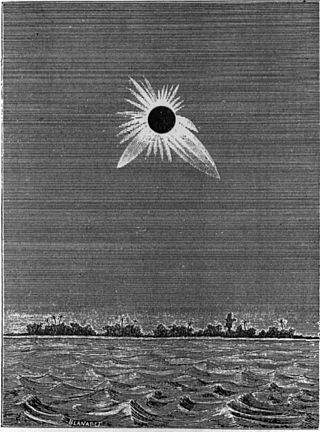 An artist's depiction of the total solar eclipse, observed from Caroline Atoll, Caroline Islands. | |
| Type of eclipse | |
| Nature | Total |
| Gamma | −0.425 |
| Magnitude | 1.0634 |
| Maximum eclipse | |
| Duration | 358 s (5 min 58 s) |
| Coordinates | 8°06′S 144°36′W / 8.1°S 144.6°W |
| Max. width of band | 229 km (142 mi) |
| Times (UTC) | |
| Greatest eclipse | 21:53:49 |
| References | |
| Saros | 136 (30 of 71) |
| Catalog # (SE5000) | 9241 |
A total solar eclipse occurred at the Moon's descending node of orbit between Sunday, May 6, and Monday, May 7, 1883, with a magnitude of 1.0634. A solar eclipse occurs when the Moon passes between Earth and the Sun, thereby totally or partly obscuring the image of the Sun for a viewer on Earth. A total solar eclipse occurs when the Moon's apparent diameter is larger than the Sun's, blocking all direct sunlight, turning day into darkness. Totality occurs in a narrow path across Earth's surface, with the partial solar eclipse visible over a surrounding region thousands of kilometres wide. Occurring about 1.1 days after perigee (on May 5, 1883, at 20:20 UTC), the Moon's apparent diameter was larger.[1]
The path of totality was visible from parts of the South Pacific Ocean. A partial solar eclipse was also visible for parts of eastern Australia, Oceania, Hawaii, Central America, and western South America.
Observations
[edit]An expedition of American astronomers traveled from Peru to Caroline Island aboard the USS Hartford to observe the total solar eclipse. A French expedition also observed the eclipse from Caroline, and the United States Navy mapped the atoll.[2] Johann Palisa, a member of the expedition, discovered an asteroid later that year which he named Carolina "in remembrance of his visit to [the] island".[3]
Eclipse details
[edit]Shown below are two tables displaying details about this particular solar eclipse. The first table outlines times at which the moon's penumbra or umbra attains the specific parameter, and the second table describes various other parameters pertaining to this eclipse.[4]
| Event | Time (UTC) |
|---|---|
| First Penumbral External Contact | 1883 May 06 at 19:21:10.1 UTC |
| First Umbral External Contact | 1883 May 06 at 20:18:44.5 UTC |
| First Central Line | 1883 May 06 at 20:20:08.5 UTC |
| First Umbral Internal Contact | 1883 May 06 at 20:21:32.7 UTC |
| First Penumbral Internal Contact | 1883 May 06 at 21:34:45.7 UTC |
| Equatorial Conjunction | 1883 May 06 at 21:45:09.2 UTC |
| Greatest Eclipse | 1883 May 06 at 21:53:48.9 UTC |
| Greatest Duration | 1883 May 06 at 21:56:03.6 UTC |
| Ecliptic Conjunction | 1883 May 06 at 21:58:10.3 UTC |
| Last Penumbral Internal Contact | 1883 May 06 at 22:13:04.8 UTC |
| Last Umbral Internal Contact | 1883 May 06 at 23:26:12.7 UTC |
| Last Central Line | 1883 May 06 at 23:27:35.7 UTC |
| Last Umbral External Contact | 1883 May 06 at 23:28:58.4 UTC |
| Last Penumbral External Contact | 1883 May 07 at 00:26:34.2 UTC |
| Parameter | Value |
|---|---|
| Eclipse Magnitude | 1.06341 |
| Eclipse Obscuration | 1.13085 |
| Gamma | −0.42503 |
| Sun Right Ascension | 02h54m04.8s |
| Sun Declination | +16°37'58.2" |
| Sun Semi-Diameter | 15'50.7" |
| Sun Equatorial Horizontal Parallax | 08.7" |
| Moon Right Ascension | 02h54m25.5s |
| Moon Declination | +16°12'38.1" |
| Moon Semi-Diameter | 16'35.5" |
| Moon Equatorial Horizontal Parallax | 1°00'53.6" |
| ΔT | -5.6 s |
Eclipse season
[edit]This eclipse is part of an eclipse season, a period, roughly every six months, when eclipses occur. Only two (or occasionally three) eclipse seasons occur each year, and each season lasts about 35 days and repeats just short of six months (173 days) later; thus two full eclipse seasons always occur each year. Either two or three eclipses happen each eclipse season. In the sequence below, each eclipse is separated by a fortnight.
| April 22 Ascending node (full moon) |
May 6 Descending node (new moon) |
|---|---|

| |
| Partial lunar eclipse Lunar Saros 110 |
Total solar eclipse Solar Saros 136 |
Related eclipses
[edit]Eclipses in 1883
[edit]- A partial lunar eclipse on April 22.
- A total solar eclipse on May 6.
- A partial lunar eclipse on October 16.
- An annular solar eclipse on October 30.
Metonic
[edit]- Preceded by: Solar eclipse of July 19, 1879
- Followed by: Solar eclipse of February 22, 1887
Tzolkinex
[edit]- Preceded by: Solar eclipse of March 25, 1876
- Followed by: Solar eclipse of June 17, 1890
Half-Saros
[edit]- Preceded by: Lunar eclipse of May 1, 1874
- Followed by: Lunar eclipse of May 11, 1892
Tritos
[edit]- Preceded by: Solar eclipse of June 6, 1872
- Followed by: Solar eclipse of April 6, 1894
Solar Saros 136
[edit]- Preceded by: Solar eclipse of April 25, 1865
- Followed by: Solar eclipse of May 18, 1901
Inex
[edit]- Preceded by: Solar eclipse of May 26, 1854
- Followed by: Solar eclipse of April 17, 1912
Triad
[edit]- Preceded by: Solar eclipse of July 4, 1796
- Followed by: Solar eclipse of March 7, 1970
Solar eclipses of 1880–1884
[edit]This eclipse is a member of a semester series. An eclipse in a semester series of solar eclipses repeats approximately every 177 days and 4 hours (a semester) at alternating nodes of the Moon's orbit.[5]
The solar eclipses on January 11, 1880 (total), July 7, 1880 (annular), and December 31, 1880 (partial) occur in the previous lunar year eclipse set, and the partial solar eclipse on March 27, 1884 occurs in the next lunar year eclipse set.
| Solar eclipse series sets from 1880 to 1884 | ||||||
|---|---|---|---|---|---|---|
| Ascending node | Descending node | |||||
| Saros | Map | Gamma | Saros | Map | Gamma | |
| 111 | December 2, 1880 Partial |
−1.5172 | 116 | May 27, 1881 Partial |
1.1345 | |
| 121 | November 21, 1881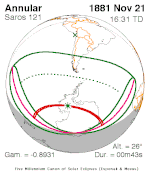 Annular |
−0.8931 | 126 | May 17, 1882 Total |
0.3269 | |
| 131 | November 10, 1882 Annular |
−0.2056 | 136 | May 6, 1883 Total |
−0.4250 | |
| 141 | October 30, 1883 Annular |
0.5030 | 146 | April 25, 1884 Partial |
−1.1365 | |
| 151 | October 19, 1884 Partial |
1.1892 | ||||
Saros 136
[edit]This eclipse is a part of Saros series 136, repeating every 18 years, 11 days, and containing 71 events. The series started with a partial solar eclipse on June 14, 1360. It contains annular eclipses from September 8, 1504 through November 12, 1594; hybrid eclipses from November 22, 1612 through January 17, 1703; and total eclipses from January 27, 1721 through May 13, 2496. The series ends at member 71 as a partial eclipse on July 30, 2622. Its eclipses are tabulated in three columns; every third eclipse in the same column is one exeligmos apart, so they all cast shadows over approximately the same parts of the Earth.
The longest duration of annularity was produced by member 9 at 32 seconds on September 8, 1504, and the longest duration of totality was produced by member 34 at 7 minutes, 7.74 seconds on June 20, 1955. All eclipses in this series occur at the Moon’s descending node of orbit.[6]
| Series members 26–47 occur between 1801 and 2200: | ||
|---|---|---|
| 26 | 27 | 28 |
 March 24, 1811 |
 April 3, 1829 |
 April 15, 1847 |
| 29 | 30 | 31 |
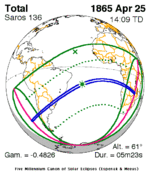 April 25, 1865 |
 May 6, 1883 |
 May 18, 1901 |
| 32 | 33 | 34 |
 May 29, 1919 |
 June 8, 1937 |
 June 20, 1955 |
| 35 | 36 | 37 |
 June 30, 1973 |
 July 11, 1991 |
 July 22, 2009 |
| 38 | 39 | 40 |
 August 2, 2027 |
 August 12, 2045 |
 August 24, 2063 |
| 41 | 42 | 43 |
 September 3, 2081 |
 September 14, 2099 |
 September 26, 2117 |
| 44 | 45 | 46 |
 October 7, 2135 |
 October 17, 2153 |
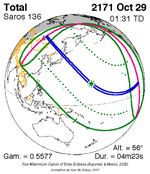 October 29, 2171 |
| 47 | ||
 November 8, 2189 | ||
Metonic series
[edit]The metonic series repeats eclipses every 19 years (6939.69 days), lasting about 5 cycles. Eclipses occur in nearly the same calendar date. In addition, the octon subseries repeats 1/5 of that or every 3.8 years (1387.94 days). All eclipses in this table occur at the Moon's descending node.
| 22 eclipse events between February 23, 1830 and July 19, 1917 | ||||
|---|---|---|---|---|
| February 22–23 | December 11–12 | September 29–30 | July 18–19 | May 6–7 |
| 108 | 110 | 112 | 114 | 116 |
 February 23, 1830 |
 July 18, 1841 |
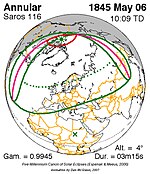 May 6, 1845 | ||
| 118 | 120 | 122 | 124 | 126 |
 February 23, 1849 |
 December 11, 1852 |
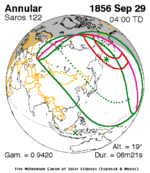 September 29, 1856 |
 July 18, 1860 |
 May 6, 1864 |
| 128 | 130 | 132 | 134 | 136 |
 February 23, 1868 |
 December 12, 1871 |
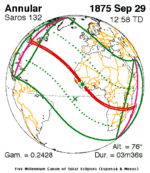 September 29, 1875 |
 July 19, 1879 |
 May 6, 1883 |
| 138 | 140 | 142 | 144 | 146 |
 February 22, 1887 |
 December 12, 1890 |
 September 29, 1894 |
 July 18, 1898 |
 May 7, 1902 |
| 148 | 150 | 152 | 154 | |
 February 23, 1906 |
 December 12, 1909 |
 September 30, 1913 |
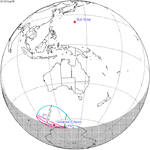 July 19, 1917 | |
Tritos series
[edit]This eclipse is a part of a tritos cycle, repeating at alternating nodes every 135 synodic months (≈ 3986.63 days, or 11 years minus 1 month). Their appearance and longitude are irregular due to a lack of synchronization with the anomalistic month (period of perigee), but groupings of 3 tritos cycles (≈ 33 years minus 3 months) come close (≈ 434.044 anomalistic months), so eclipses are similar in these groupings.
The partial solar eclipses on December 18, 2188 (part of Saros 164) and November 18, 2199 (part of Saros 165) are also a part of this series but are not included in the table below.
| Series members between 1801 and 2134 | ||||
|---|---|---|---|---|
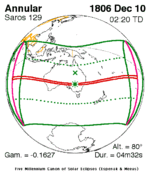 December 10, 1806 (Saros 129) |
 November 9, 1817 (Saros 130) |
 October 9, 1828 (Saros 131) |
 September 7, 1839 (Saros 132) |
 August 7, 1850 (Saros 133) |
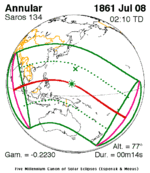 July 8, 1861 (Saros 134) |
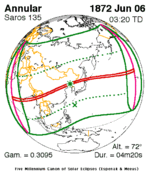 June 6, 1872 (Saros 135) |
 May 6, 1883 (Saros 136) |
 April 6, 1894 (Saros 137) |
 March 6, 1905 (Saros 138) |
 February 3, 1916 (Saros 139) |
 January 3, 1927 (Saros 140) |
 December 2, 1937 (Saros 141) |
 November 1, 1948 (Saros 142) |
 October 2, 1959 (Saros 143) |
 August 31, 1970 (Saros 144) |
 July 31, 1981 (Saros 145) |
 June 30, 1992 (Saros 146) |
 May 31, 2003 (Saros 147) |
 April 29, 2014 (Saros 148) |
 March 29, 2025 (Saros 149) |
 February 27, 2036 (Saros 150) |
 January 26, 2047 (Saros 151) |
 December 26, 2057 (Saros 152) |
 November 24, 2068 (Saros 153) |
 October 24, 2079 (Saros 154) |
 September 23, 2090 (Saros 155) |
 August 24, 2101 (Saros 156) |
 July 23, 2112 (Saros 157) |
 June 23, 2123 (Saros 158) |
 May 23, 2134 (Saros 159) | ||||
Inex series
[edit]This eclipse is a part of the long period inex cycle, repeating at alternating nodes, every 358 synodic months (≈ 10,571.95 days, or 29 years minus 20 days). Their appearance and longitude are irregular due to a lack of synchronization with the anomalistic month (period of perigee). However, groupings of 3 inex cycles (≈ 87 years minus 2 months) comes close (≈ 1,151.02 anomalistic months), so eclipses are similar in these groupings.
| Series members between 1801 and 2200 | ||
|---|---|---|
 June 16, 1825 (Saros 134) |
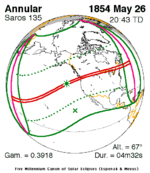 May 26, 1854 (Saros 135) |
 May 6, 1883 (Saros 136) |
 April 17, 1912 (Saros 137) |
 March 27, 1941 (Saros 138) |
 March 7, 1970 (Saros 139) |
 February 16, 1999 (Saros 140) |
 January 26, 2028 (Saros 141) |
 January 5, 2057 (Saros 142) |
 December 16, 2085 (Saros 143) |
 November 27, 2114 (Saros 144) |
 November 7, 2143 (Saros 145) |
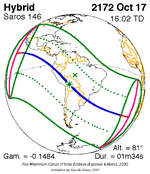 October 17, 2172 (Saros 146) |
||
Notes
[edit]- ^ "Moon Distances for London, United Kingdom, England". timeanddate. Retrieved 29 August 2024.
- ^ Bryan, E.H. (1942). American Polynesia and the Hawaiian Chain. Honolulu: Tongg Publishing Company.
- ^ Schmadel, L.D. (2000). Dictionary of Minor Planet Names (4th ed.). Berlin: Springer-Verlag Telos. ISBN 3-540-66292-8.
- ^ "Total Solar Eclipse of 1883 May 06". EclipseWise.com. Retrieved 29 August 2024.
- ^ van Gent, R.H. "Solar- and Lunar-Eclipse Predictions from Antiquity to the Present". A Catalogue of Eclipse Cycles. Utrecht University. Retrieved 6 October 2018.
- ^ "NASA - Catalog of Solar Eclipses of Saros 136". eclipse.gsfc.nasa.gov.
References
[edit]- NASA graphic
- The Total Solar Eclipse of 16th April, 1893. Report on Results Obtained with the Slit Spectroscopes, by E. H. Hills, 1894, The Royal Society.
- Scientific American: The Solar Eclipse Of May 6, 1883, Professor C. S. Hastings, of the Johns Hopkins University, also includes many interesting details in his account of the trip
- The total solar eclipse of May 6, 1883, Monthly Notices of the Royal Astronomical Society, Vol. 44, p. 180 [1]
- Some of the Meteorological Results of the Total Solar Eclipse of May 6, 1883, Nature 31, 601–601 (30 April 1885) [2]




